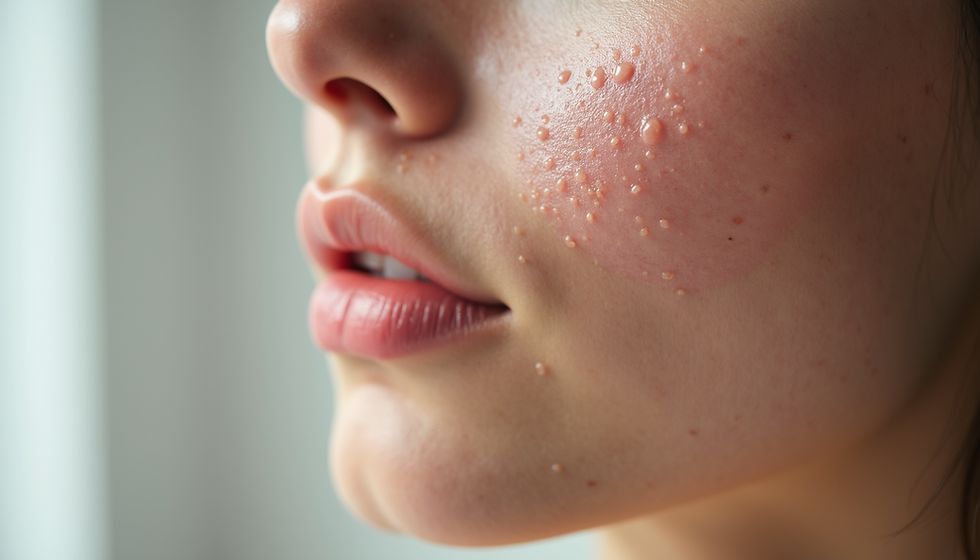Understanding Tissue Necrosis After a Breast Lift & How 3D Areola Tattoos Can Help Restore Confidence
- Bianca Cypser
- Apr 27
- 3 min read

The idea of tissue necrosis—where cells die due to disrupted blood flow—can sound alarming, especially after cosmetic procedures like a breast lift. While "necrosis" might evoke fear, it’s important to know that this condition, though serious, is manageable and relatively common in breast surgeries. Necrosis occurs when blood supply is compromised, often due to trauma, surgery, or injury, leading to the death of fatty tissue. Thankfully, it does not increase your risk of breast cancer.
How Common is Breast Tissue Necrosis After Surgery?
Since breasts are largely composed of fatty tissue—the type most prone to necrosis—this complication can occur in 4% to 25% of breast surgeries, including lifts, reductions, mastectomies, and lumpectomies. While those numbers may seem high, many cases are mild and treatable.
Recognizing the Signs of Necrosis After a Breast Lift
Early signs of tissue necrosis may include:
Yellowish fluid discharge from the incision
Red, thickened, or bruised skin patches
Dimpling or changes in skin texture
Nipple inversion or deformation
Formation of hard lumps beneath the skin
Necrosis can develop shortly after surgery—or even months to years later—making ongoing self-monitoring important.
What Does Necrotic Tissue Feel Like?
Initially, necrosis might feel like a soft, fatty lump within the breast. Over time, this can harden into a firmer nodule. While often painless, some women experience tenderness or mild discomfort.
Diagnosing Necrosis After a Breast Lift
A qualified plastic surgeon can often detect necrosis through a physical exam. Imaging tools like mammograms, MRIs, or ultrasounds may be used for a clearer picture. In some cases, a biopsy—either fine needle aspiration or core biopsy—is performed to confirm necrotic tissue.
Treatment Options for Breast Necrosis
In mild cases, no immediate treatment is needed as the body can naturally absorb dead tissue over time. However, if necrosis causes pain, aesthetic concerns, or risks infection, surgical removal might be necessary. This is typically done through a minor excision under local anesthesia. For larger areas, general anesthesia may be required.
Preventing Necrosis: What You Can Do
While there’s no guaranteed way to prevent necrosis, you can reduce your risk by:
Quitting smoking well before surgery (nicotine severely impairs blood flow)
Choosing a board-certified plastic surgeon skilled in advanced blood-preserving techniques
Following all post-operative care instructions meticulously
Nipple and Areola Necrosis: A Rare but Treatable Complication
One of the most distressing complications for patients is nipple necrosis after a breast lift. Thankfully, it’s rare due to modern surgical techniques that preserve blood flow to the nipple-areola complex via a "pedicle."
In cases where necrosis does affect the nipple or areola, treatment ranges from minor debridement to full removal of the affected tissue. If the nipple and areola cannot be saved, surgical reconstruction is one option—but many women today are turning to a less invasive, highly aesthetic solution: 3D Areola Tattoos.
Restore Your Confidence with 3D Areola Tattooing
If you've experienced nipple or areola loss due to necrosis, 3D areola tattooing offers a remarkable way to reclaim your body image. Skilled medical tattoo artists can create hyper-realistic, three-dimensional nipple and areola designs that look incredibly natural—even up close.
This advanced tattooing technique uses shading and color gradients to give the illusion of depth and texture, helping restore symmetry and confidence without additional surgery. Whether done as a standalone solution or as a complement to surgical reconstruction, 3D areola tattoos have become a transformative option for many breast surgery patients.
Infection vs. Necrosis: Know the Difference
Both infections and necrosis can cause redness and discharge, but key differences include:
Infection: Often presents with fever and warmth around the affected area. Treatable with antibiotics.
Necrosis: No fever or warmth. Dead tissue must be removed or absorbed naturally.
Final Thoughts
While necrosis after a breast lift can be unsettling, it's a manageable condition when identified early and treated appropriately. If nipple or areola necrosis occurs, remember that solutions like 3D areola tattoos can beautifully restore your natural appearance, helping you feel whole and confident again.






(1)_edited.png)



fedgpu fedgpu
fedgpu fedgpu
fedgpu fedgpu
fedgpu fedgpu
fedgpu fedgpu
fedgpu fedgpu
gscai gscai
gscai gscai
gscai gscai
gscai gscai
gscai gscai
gscai gscai
fedgpu fedgpu
fedgpu fedgpu
fedgpu fedgpu
fedgpu fedgpu
fedgpu fedgpu
fedgpu fedgpu
gscai gscai
gscai gscai
gscai gscai
gscai gscai
gscai gscai
gscai gscai
fedgpu fedgpu
fedgpu fedgpu
fedgpu fedgpu
fedgpu fedgpu
fedgpu fedgpu
fedgpu fedgpu
gscai gscai
gscai gscai
gscai gscai
gscai gscai
gscai gscai
gscai gscai
fedgpu fedgpu
fedgpu fedgpu
fedgpu fedgpu
fedgpu fedgpu
fedgpu fedgpu
fedgpu fedgpu
gscai gscai
gscai gscai
gscai gscai
gscai gscai
gscai gscai
gscai gscai
fedgpu fedgpu
fedgpu fedgpu
fedgpu fedgpu
fedgpu fedgpu
fedgpu fedgpu
fedgpu fedgpu
gscai gscai
gscai gscai
gscai gscai
gscai gscai
gscai gscai
gscai gscai